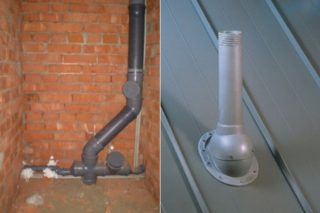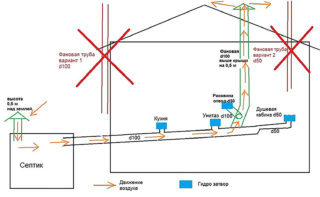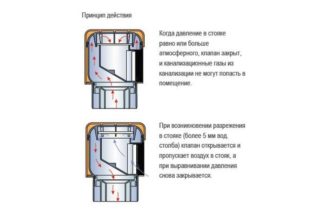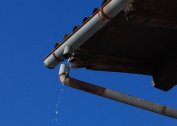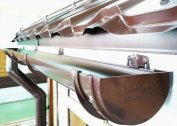A fan riser in a private house is designed to compensate for the vacuum that occurs when a large volume of drains is discharged. With its help, the gas accumulated in the pipes is removed, as a result of which the device got its name, which is translated from English as “funny”. This is the connecting element between the sewer well and the atmosphere.
The device and principle of operation of the fan pipe
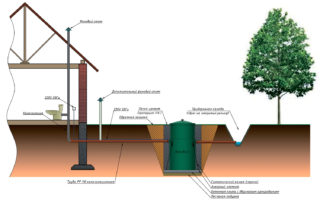 When salvo discharge in the drainage system, a vacuum is formed. If there is no air inflow from the outside, equalization of pressure will lead to the suction of water plugs from the siphons of the sewer devices installed in the bathroom. At the same time, loud squelching sounds appear, and unpleasant odors burst into the apartment. The siphon is a curved pipe, which is installed in a vertical or horizontal position under sinks, bathtubs and toilets. When filling it with water, a water trap is formed, which prevents the accumulation of accumulated gases from the sewer into the living room.
When salvo discharge in the drainage system, a vacuum is formed. If there is no air inflow from the outside, equalization of pressure will lead to the suction of water plugs from the siphons of the sewer devices installed in the bathroom. At the same time, loud squelching sounds appear, and unpleasant odors burst into the apartment. The siphon is a curved pipe, which is installed in a vertical or horizontal position under sinks, bathtubs and toilets. When filling it with water, a water trap is formed, which prevents the accumulation of accumulated gases from the sewer into the living room.
The fan pipe provides air to the discharge zone without disrupting the hydraulic seal system. The main devices guilty of the appearance of a local low-pressure area are toilet bowls and washing machines that drain water under pressure, as a result of which the lumen of the vertical sewer riser is completely blocked.
The fan pipe does not allow the appearance of vacuum, filling the vacated space with air. The second purpose of the device is to create traction to remove accumulated gases.
Production material
Since the riser outlet is one of the components of the intra-house sewer system, the same materials are used for its production as for other wiring elements. Mostly cast iron and plastic pipes are used. The former have high strength, but when defects appear, they begin to collapse under the influence of corrosion. In addition, it is quite difficult to strengthen a heavy cast iron pipe in an upright position.
An alternative is the use of polymer pipes. They are durable and lightweight, do not corrode and have a low cost. Making the installation of a sewer system using plastic pipes and fittings is much easier than connecting cast iron elements. The advantage of polymer products in a smooth inner surface, which eliminates siltation of the pipe system. Pig-iron products are rough inside, which is one of the reasons for operational blockages.
For normal operation, the diameter of the fan pipe must correspond to the largest cross-section of the pipe connection. According to the rules of SNiP, the largest diameter of the pipes for connection to the wastewater system is toilet bowls: 100-110 mm, therefore, the outlet pipe must have a cross section of the same size - 110 mm.
Rules for installing a fan pipe in a private house
According to current building codes, pipes must be installed starting from two-story buildings. However, experts believe that this device in a one-story individual building will also ensure the proper functioning of the sewage system. If the house has a toilet bowl, sinks, shower, washing machine and dishwasher, a sewer pipe is needed.
Since the risk of a complete overlap of the cross section depends directly on the volume of incoming effluents, there is no need to bring the riser to the roof for the country house, due to its short-term use and the minimum number of plumbing fixtures.
Common installation errors
Installing a fan riser does not cause difficulties and is performed during the installation of the internal sewer system. If the drains of all plumbing devices have a tie-in in one riser, one pipe is enough. Otherwise, when the plumbing fixtures are removed from each other, it makes no sense to pull the pipelines to connect them to one fan riser, as the draft decreases with an increase in the length of horizontal sections. In this situation, each sewer riser is mounted with a conclusion to the roof and is equipped with a fly lamp.
A significant temperature difference, especially in winter, contributes to the effective removal of gases, since their temperature in a heated room is higher than the temperature of the outside air.
Vertical installation of the fan riser is carried out using clamps that are attached to the wall. They securely lock the device. For sound insulation, the riser is covered with a mineral canvas in rolls or slabs.
The output is performed in 2 ways:
- through the riser;
- with the manufacture of pipes on the roof of the structure.
The installation of the latter is carried out in accordance with the requirements:
- with a flat surface, the height should be 0.3 m;
- above the pitched roof not less than 0.5 m;
- when using the roof for economic purposes, the permissible height of the fan pipe must be at least 3 m.
So that the smell of sewage does not penetrate into the living room, the outlet of the riser is located at a distance of at least 4 m from the windows. Decorating it with decorative elements will lead to the condensation of vapors on their surface. In winter, this is fraught with icing of the fan pipe, which, in turn, narrows its clearance and reduces the efficiency of the device.
Another installation error happens when the homeowner tries to move the pipe outlet to a secluded place on the roof to give the house a more aesthetic look. All horizontal movements reduce air velocity.
Experts do not recommend making fungus on top of the pipe so that the riser hole does not overlap when icing it.
The non-return valve prevents backflow of gases and protects the riser from blockages. However, the vacuum valve is not able to replace the fan pipe, especially when the fluid dries in the hydraulic locks.
Users often wonder how to exit for sewer gases if the house is already built and tiled. Installation between the house and the septic tank will not give the desired effect. During installation, it is recommended that the riser be brought out as close to the ridge of the roof as possible so that when the snow does not blow down the fan element, as it happens if it is installed under the overhang.
The correct decision is the conclusion through the roof. At the same time, you do not need to get into the rafter crate. The sewer outlet in the middle lane should be insulated so that it does not freeze in winter in severe frosts. With the help of a drill, an opening with an exit to the outside is planned. The inner riser must enter the protrusion of the exit element. It is very unlikely that it will directly fall under a hole in the roof, so a corrugated pipe is used as a connecting element.
In order for the penetration to stand tightly on the roofing, special elements are used that are placed under the output. Around the intended hole on the stencil cut out the flooring. In the place where the waterproofing film will be damaged, put a seal of the water seal, carefully bending it with your hands along the metal profile. This will not allow water flowing from the roof. A special silicone sealant (without vinegar) is applied between the sealant and the roof, and screws are screwed. The base of the penetration is fixed to the roof, and a sewer outlet is mounted on top.
If the site has a septic tank with biological treatment using microorganisms, the intake of fresh air through a fan riser is vital for them.
